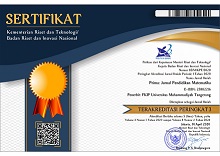IMPLEMENTATION OF THE INQUIRY-FLIPPED CLASSROOM MODEL ASSISTED BY EDPUZZLE ON STUDENTS' CREATIVE THINKING
Abstract
The purpose of this research is to improve the creative thinking ability of SMP Negeri 1 Cibadak students through the application of Inquiry-Flipped classrom assisted by Edpuzzle. This quantitative research uses a pseudo-experimental method and a control group of pretest and posttest. There were two subjects involved, namely two experimental classes and one control class with a total of 91 students in grade VII of SMP Negeri 1 Cibadak. To analyze the data, a single-track anava test was used with prerequisites, normality and homogeneity tests. A creative thinking ability test instrument was used in this study which showed the findings that the Inquiry-Flipped Classroom model assisted by Edpuzzle was better than the Inquiry-Flipped Classrom model and direct learning.
Keywords: Inquiry, Flipped classroom, edpuzzle, creative thinking
Full Text:
PDFReferences
Agustin, S. E., Yandari, I. A. V., & Yuhana, Y. (2024). Development of Learning Media Based on Edpuzzle Application on Flat Building Materials for Grade IV Elementary School. Scientific Journal of the Education Profession, 9(1), 119–128. https://doi.org/10.29303/jipp.v9i1.1839
Amaliah. (2020). Vol. 14, No. 1, April 2020. Prosodi, 14(1), 65–71.
Amin, M., & Ibrahim, M. (2022). Meta-Analysis: The Effectiveness of Stem on Students' Creative Thinking Ability. Journal of Authentic Research on Mathematics Education (JARME), 4(2), 248–262. https://doi.org/10.37058/jarme.v4i2.4844
Aprilia, A. A. (2020). Efforts to reduce misconceptions in physics learning through the inquiry learning model. Journal of Physics Education, 8(2), 1–7.
Dalilan, R., & Sofyan, D. (2022). Junior High School Students' Mathematical Creative Thinking Ability is reviewed from Self Confidence. Plusminus: Journal of Mathematics Education, 2(1), 141–150. https://doi.org/10.31980/plusminus.v2i1.1585
Desmarani, S., Rusdi, M., Dewi, F., & Bakar, A. (2021). Development of Inquiry-Flipped Classroom-Based E-Lkpd to Improve Students' Creative Thinking Skills on Chemical Bond Material. University of Jambi, 1–13.
Fauzan, M., Haryadi, H., & Haryati, N. (2021). Application of the Elaboration of the Flipped Classroom Model and Google Classroom Media as a Solution for Learning Indonesian Language in the 21st Century. DWIJA CENDEKIA: Journal of Pedagogic Research, 5(2), 361. https://doi.org/10.20961/jdc.v5i2.55779
Hamid B, L. O. M. I., & Suryadi, R. (2021). Implementation of the Sole Model Learning (Self Organized Learning Environment) Assisted by the Edpuzzle Application in Online Learning. Scientific Development Media, 16(5), 6983–6692. http://ejurnal.binawakya.or.id/index.php/MBI/article/view/1400
Hasanah, M. & H. (2021). Analysis of Mathematical Creative Thinking Skills of Grade VIII Junior High School Students on Statistics Material. Maju, 8(1), 233–243.
Lestari, T. P., & Sofyan, D. (2013). Comparison of problem-solving process skills between students who use Creative Problem Solving (CPS) and conventional learning. Mosharafa : Journal of Mathematics Education, 2(September), 179–190.
Pangestu, N. S., & Hasti Yunianta, T. N. (2019). Mathematical Creative Thinking Process of Extroverted and Introverted Students of Junior High School Class VIII Based on Wallas Stages. Mosharafa: Journal of Mathematics Education, 8(2), 215–226. https://doi.org/10.31980/mosharafa.v8i2.472
Paristiowati, M., Fitriani, E., & Aldi, N. H. (2017). The effect of inquiry-flipped classroom model toward students' achievement on chemical reaction rate. AIP Conference Proceedings, 1868. https://doi.org/10.1063/1.4995105
Putri, C., Bambang, R. M. S., & Maidiyah, E. (2021). Mathematical Creative Thinking Skills of Grade VII Students on Rectangular Materials at SMPN 1 Seunagan. Scientific Journal of Education Students ..., 6(3), 202. http://www.jim.unsyiah.ac.id/pendidikan-matematika/article/view/18342%0Ahttp://www.jim.unsyiah.ac.id/pendidikan-matematika/article/download/18342/8777
Rahayu, R., Rosita, R., Rahayuningsih, Y. S., Hernawan, A. H., & Prihantini. (2022). Implementation of Independent Curriculum in Driving School. Journal of Basicedu, 6(4), 6313–6319.
Saidah, Dwijanto, & I. J. (2020). Students' Creative Thinking Skills in Mathematics Learning. Journal of Educational Sciences, 2012, 1042–1045.
Sugiyono. (2017). Quantitative, qualitative, and R&D research methods. Alphabeta.
Sugiyono. (2019). Qualitative Quantitative Research Methods and R&D. Alfabeta Bandung.
Sugiyono. (2022). Qualitative quantitative research methods and R&D. Alphabeta.
Sumartini, T. S. (2022). The Influence of Habit of Mind on Mathematical Creative Thinking Ability through the Improve Learning Method. Mosharafa: Journal of Mathematics Education, 11(1), 167–178. https://doi.org/10.31980/mosharafa.v11i1.1253
Wicaksono, A. B., Khabibah, S., & Masriyah, M. (2022). High School Mathematics Teacher's Conception of Creative Thinking. Edumatica : Journal of Mathematics Education, 12(03), 249–255. https://doi.org/10.22437/edumatica.v12i03.22667
Zahra, A., & Solihati, N. (2023). Analysis of HOTS (High Order Thinking Skills) on Final Semester Assessment Questions (PAS) in Lower Grade Students of SDN Jatimurni V Bekasi City. Scientific Journal of Batanghari University Jambi, 23(3), 2662. https://doi.org/10.33087/jiubj.v23i3.4174
DOI: http://dx.doi.org/10.31000/prima.v8i3.12157
Article Metrics
Abstract - 1145 PDF - 620Refbacks
- There are currently no refbacks.
Prima: Jurnal Pendidikan Matematika
Program Studi Pendidikan Matematika
Fakultas Keguruan dan Ilmu Pendidikan
Universitas Muhammadiyah Tangerang
Jl. Perintis Kemerdekaan I/33, Cikokol
Kota Tangerang, Indonesia
e-mail: primajpm@gmail.com
Prima: Jurnal Pendidikan Matematika (p-ISSN: 2579-9827 | e-ISSN: 2580-2216) is licensed under a Creative Commons Attribution 4.0 International License.







